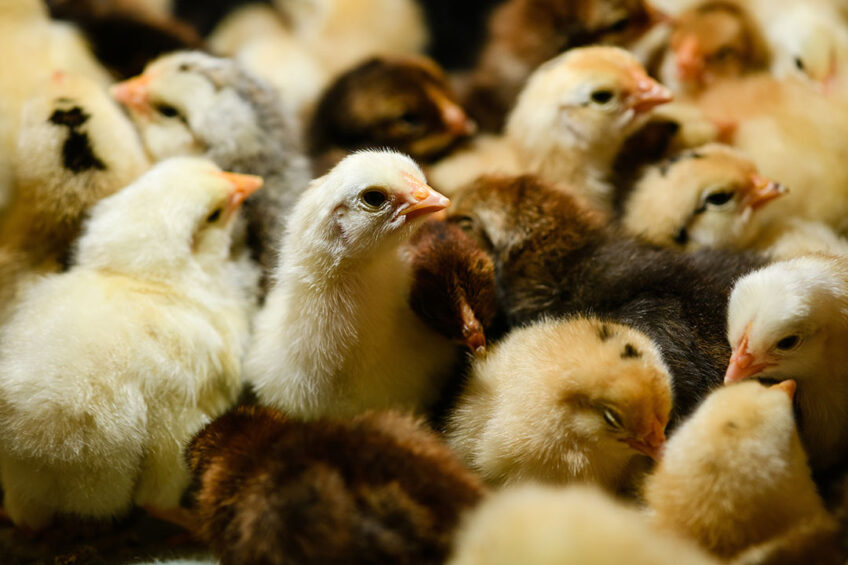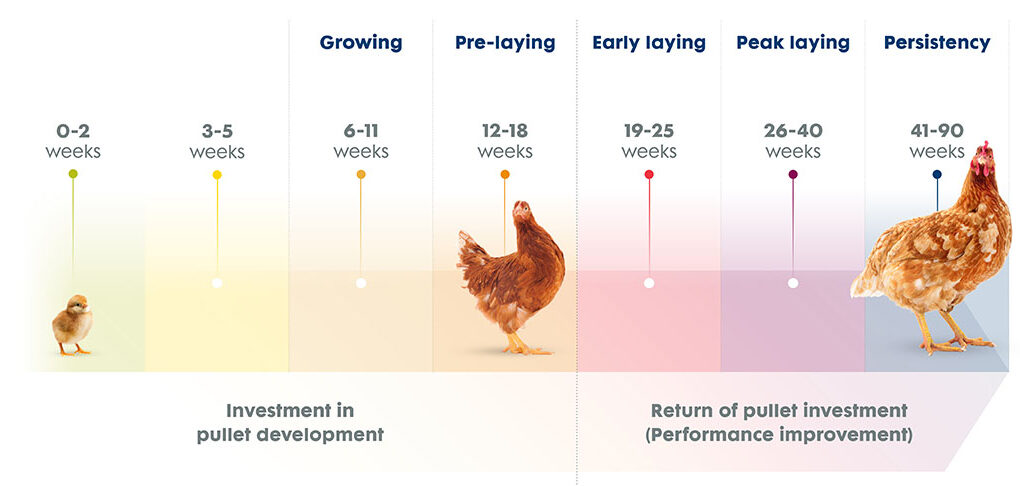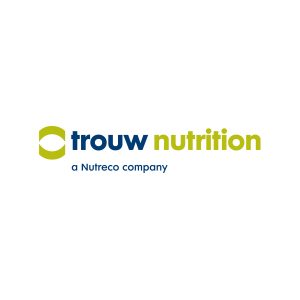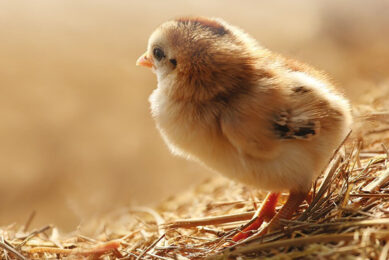Pullets: Get it right in the first 2 weeks

The first 2 weeks of a pullet’s life are crucial. In this brief period after hatch, the body of the young bird changes drastically. This is the window where we can positively influence a range of performance parameters to create long-lasting effects.
Layer farms have successfully increased the efficiency and productivity of laying hens over the years. At the same time, production costs have increased, making egg production a delicate balance of margins.
Different variables can impact the overall profitability of the farm. However, the investment in the number of pullets housed at day 1, versus how many can produce to their genetic potential is one of the main success indicators for every layer farmer. When development in one phase is not optimal, the next phase is also automatically affected. Investing in pullets up to 18 weeks of age is therefore crucial to produce robust, healthy, and productive layers from week 19 onwards (Figure 1). The first 2 weeks are essential here.
Figure 1 – Investing in early pullet development is crucial for the whole production cycle of a layer.

Massive functional growth
Producing strong pullets requires a multifactorial approach and depends on good management and disease control, among others. While nutrition is what makes the bird grow and thrive, the same diet does not work for all phases.
A layer’s nutrient requirements and digestibility vary greatly between the different phases, especially when we compare young animals with older layers. In the first days and weeks after hatch, the pullet’s body changes drastically. The internal organs, the bones and overall body weight grow and develop fast. A pullet has the highest body weight increase in the first 2 weeks of life. We also see a massive growth of the intestinal tract (faster than other organs) in the first days and a spike in bone and muscle growth and development. This so-called functional growth requires a lot of highly digestible protein and high levels of energy. At the same time, nutrient reserves, feed digestibility and feed intake levels are low.
Roland Koedijk, global head of poultry nutrition at Trouw Nutrition, explains: “A nutrient deficiency from the start can result in long-lasting, irreversible deficits and high mortality levels in the rearing phase. The newborn chick, therefore, relies on dietary energy and protein sources to meet its requirements for maintenance and functional growth.”
Re-evaluating feeding phases
The differences in nutrient requirements and digestibility between the different age groups are common knowledge. This is why commercial layer farms often apply 3 different feeding phases: a starter/grower diet, a developer diet, and a pre-peak diet.
The different diets/feeding phases applied should support all development periods in their own way. Yet, simple starter diets often come as mash feed or a crumble and do not meet the nutritional requirements of the pullets. Additionally, these diets may lack the composition for optimal feed intake and gut development in the first 2 weeks. The risks of feeding a starter diet not tailored to the needs of pullets are underfeeding and irreversible negative effects.
“In the broiler industry, the use of a pre-starter in the first days after hatch has become a growing practice, as it clearly shows the benefits of getting the birds market-ready in a certain number of weeks. In the layer industry, the use of a pre-starter (before a starter/grower diet) is not as common yet. This is not because layer farmers do not see the benefits. Instead, it is often the result of feeding practices that are most practical and efficient and have been applied for many years. It takes time to change feeding practices and protocols. In addition, layer integrations that produce their own diets do not always have the possibility or specific formulation and processing support to make a pre-starter feed in their own feed mill. This is why we developed Erliva PullyCare,” Koedijk explains.
Developing the ultimate pre-starter
Erliva PullyCare is an innovative pre-starter feed optimised for nutritional profile, ingredients, and physical form.
“Next to our ingredient selection and the use of a micro-pellet, our knowledge on the kinetics of protein and fibre digestion is an important part of this innovation. Young animals cannot handle slow protein sources, which can flare up pathogen growth in the gastrointestinal tract. If we use protein ingredients that are ‘faster’, the pullet can utilise the protein faster and better. For fibre-rich nutrients, we must find the balance in structure levels to both optimise gizzard and intestinal/gut development,” Koedijk addresses.
The focus on digestion and nutrient utilisation leads to faster bodyweight growth from an early age, which has a positive effect on the start of laying, the average egg size and the persistency of the peak of production.
“But we also showed that our pre-starter has an effect on the size of the birds and hence bone size. Taller bones are equipped with a larger calcium reservoir and allow for better calcium turnover, which is required for optimal shell calcification and eggshell quality. This shows that a pre-starter can really add value for our customers and increase the economic performance of the layer farm,” Koedijk concludes.
In the next 2 articles on Poultry World, we will delve into the trial results and the experiences of early adopters.






